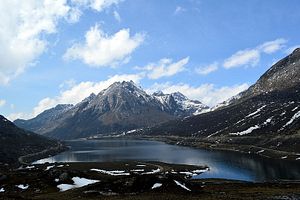On January 3, news reports emerged in India that China had crossed 200 meters into Indian territory in Arunachal Pradesh — an Indian state that China claims in its entirety — with road construction material. National security analysts and the media alike were concerned that the two nations may have been headed towards another tense standoff such as the one just months earlier in the Doklam plateau, where China had similarly entered disputed territory with road construction equipment.
Although Indian and Chinese officials confirmed that no standoff had taken place, this incident highlighted how India has remained resolute amidst growing Chinese incursions along the border. These challenges to Indian border security have occurred as China has become more forceful in its protests when Indian officials visit the border state of Arunachal Pradesh. As Indian Prime Minister Narendra Modi plans a visit to Arunachal Pradesh in early 2018, India is sending a clear signal that it will stand firm despite China’s attempts to test it over Arunachal Pradesh.
China’s Continuing Tests and Protests
Border incursions over the Sino-Indian border occur regularly as part of what India’s Chief of Army Staff General Bipin Rawat has called China’s “salami tactics.” These tactics encompass “small, stealth military operations against neighboring countries which accumulate over time in a large territorial gain.” In Arunachal Pradesh, these military incursions, while small enough to avoid risking a war or capturing international attention, challenge India’s tolerance threshold on the border and aim to steadily, but cumulatively, alter the status quo on the ground and expand China’s claims to territorial jurisdiction in the region.
Border incursions, including the one on December 26, are “designed to embarrass India’s leadership… and to show the Indian public and the world that China can operate at the border with impunity while underscoring Modi’s inability to secure India’s sovereign borders,” according to Jeff M. Smith, a South Asia Research Fellow at the Heritage Foundation.
Indeed, the timing of the December incursion, which came days after Yang Jiechi, Member of Politburo of Communist Party of China’s Central Committee and China’s Special Representative on the India-China Boundary Question, delivered messages of friendship “for generations,” is part of a pattern of “repeated border intrusions… frequently interspersed with diplomatic sweet talk.”
However, China’s aim to expand its territorial gains in Arunachal Pradesh through salami-slicing are often also combined with road-building and other infrastructure projects. Such projects bolster the effectiveness of its tactics as well as China’s claims of jurisdiction over the territory, and exploit India’s strategic disadvantage resulting from its poor infrastructure along the border. Indeed, India has constructed barely 963 km of roads along the Line of Actual Control, and has not begun construction on any of the 28 strategic railway lines planned along the border areas. China, on the other hand, has systematically built an infrastructure network of roads, highways, railways, and military assets in the Tibet Autonomous Region, which can support over 15,000 soldiers.
Beyond salami-slicing, China has also tested India’s resolve by consistently lodging protests with the government when any Indian official has visited Arunachal Pradesh. As Chinese ambitions in the region have grown in recent years, so, too, have such protests, the latest of which came when India’s Defence Minister and President visited the northeastern state in November and December of 2017 respectively. However, despite such tests and protests, India has remained firm.
India’s Firm and Uncompromising Stance
In the face of such forceful criticisms and tests, India adopted a position of “physical denial” rather than simply expressing its disapproval of Chinese incursions or lodging diplomatic protests with the threat of punishment. This strategy was extremely effective in Doklam, and was replicated on December 26 when Indian troops pushed back Chinese troops who had crossed the border into Arunachal Pradesh and were attempting to construct a road. In repelling Chinese troops and seizing the road construction equipment, India prevented China’s bid to change the status quo.
Such a strategy has been historically successful. As Indian strategic affairs analyst Nitin A. Gokhale has noted in this publication, India has successfully pushed back Chinese troops in two earlier standoffs. In September 2014, when 1,000 Chinese troops crossed into a remote border outpost near Ladakh, India displayed a “new approach of not succumbing to Chinese bullying… New Delhi rapidly built up a 9,000-strong force in two days, forcing the PLA to back off.” When China tried again at Yangtse in Arunachal Pradesh in 2015, the faceoff concluded with the same result, “further demonstrat[ing] India’s resolve.”
India is reaffirming its commitment to stand strong against China with Prime Minister Modi’s planned visit to Arunachal Pradesh in early 2018. Reports of the intended visit underscore how India remains undeterred by Chinese protests of earlier visits by Indian officials. Prime Minister Modi’s trip also seeks reinforce that India will not compromise at all on Arunachal Pradesh, despite Chinese demands to transfer, at least, the Tawang tract of the state, and that “Arunachal Pradesh is an integral and inalienable part of India.”
As China continues to implement its salami-slicing tactics of challenges India’s tolerance on the border and trying to embarrass India’s leadership, India has stood firm, physically and rhetorically denying China the opportunity to enact de facto changes to the status quo along the border. While such a strategy of denial has been effective, India must acknowledge its limitations and make urgent progress on matching China’s infrastructure and military build-up along the border. This progress, however, must not come at the expense of India’s broader strategy against China, which depends on greater assertiveness against Chinese encroachment, not just along the border, but in the wider Indian Ocean region as well.

































